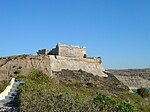Porto Dinheiro
Lisbon geography stubsLourinhãPopulated places in Lisbon District

Porto Dinheiro (or Praia de Porto Dinheiro) is a locality in the civil parish (freguesia) of Ribamar, municipality of Lourinhã, in Portugal. It is known as a rich fossil locality, from where were found many Late Jurassic dinosaurs and mammals. A few even received the locality name, like the Dinheirosaurus lourinhanensis and Jurassic mammals like Portopinheirodon asymmetricus and the multituberculates family Pinheirodontidae. The second one is the based for a new family of mammals, the Pinheirodontidae. An diverse ichnofauna is known in that site. This locality was once considered to be early Cretaceous in age, but it is Tithonian (Late Jurassic).
Excerpt from the Wikipedia article Porto Dinheiro (License: CC BY-SA 3.0, Authors, Images).Porto Dinheiro
Avenida 25 de Abril, Lourinhã
Geographical coordinates (GPS) Address Nearby Places Show on map
Geographical coordinates (GPS)
| Latitude | Longitude |
|---|---|
| N 39.2136 ° | E -9.3447 ° |
Address
Avenida 25 de Abril
Avenida 25 de Abril
2530-627 Lourinhã
Portugal
Open on Google Maps





